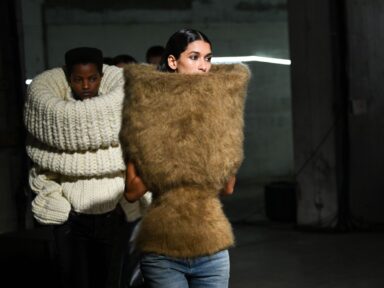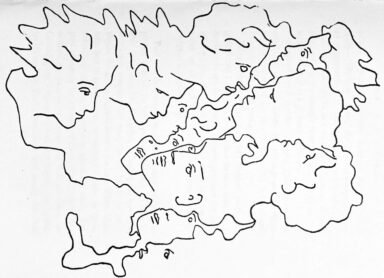Collectible DRY interviews Simone Alliva, the author of “CACCIA ALLʼOMO,” published by Fandango Libri.
In his book — a quantitative, data-based investigation spanning from the North to the South of the country — the writer and journalist has explored the phenomenon of homotransphobic violence in Italy, also referring to the latest hate incidents. From the physical episode involving a gay couple who was beaten up because of a kiss shared in public spaces to the Instagram-based homophobic attack against a model posing for Maison Valentino
Text by: Domenico Costantini
These are just a few of the reasons why we must have such a LAW NOW, once and for all. Read our interview with the author below.
Collectible DRY: As a writer and activist, how much has your practice served as a way of exploring yourself? Or is it rather the desire to explore and get to know yourself that has led you to writing?
Simone Alliva: As a passionate writer and journalist, I deal with political news. Over time, I have come to understand more and more how necessary it is in Italy to provide correct information on civil rights, which for many is still an elitist issue. I try to give voice to offended identities and fight against prejudice. I am not the pen of LGBTQ+ people, I simply try to express and reveal what is hidden. This does not always coincide with the LGBTQ+ world, but also with overlooked parts of each of us. I am interested in showing that prejudices act as killers within families, workplaces, communities, eventually harming everyone. I have always loved telling life stories. I listen and collect stories with passion because it fascinates me so much.
CD: CACCIA ALL’OMO, which is published by Fandango Libri, is a data-driven investigation that quantifies the presence of homotransphobic violence in Italy. Could you tell us something more about the numbers you’ve collected?
SA: In Italy, the cases of homotransphobia recorded in 2019 alone were 212, including two deaths. Throughout 2018, there have been 211 similar incidents. In 2017, we had 144 cases while one year earlier than that, in 2016, the estimate was 109. As I write in CACCIA ALL’OMO (Hunting the Homo), “There is something pulsing in the soul of this country and it is scary. There is a policy using language like bottle shards purposefully put up on a wall not to let in those who don’t live in the villa.” i.e. the LGBTQ+ community. To tell how this phenomenon was born, and how it is developing, seems to me the most important thing to recover on the scene of the crime.

Cover Book “CACCIA ALL’OMO” (HUNTING THE HOMOS)
published by Fandango Libri
Courtesy of Simone Alliva
CD: A few days ago, a photo was published on Maison Valentino’s Instagram account which caused quite a stir, provoking the usual aggressive, homophobic comments we’ve sadly become acquainted with. The shot in question was a self-portrait of American photographer and model Michael Bailey-Gates, who appeared naked (with his private parts suitably covered) while holding a Valentino bag with one hand and one foot. The photograph was shared by the Maison as part of the new Valentino Collezione Milano campaign.
“A freedom of expression and an appreciation for the limitlessness of individuality mark the new #ValentinoCollectionMilan campaign,” reads the caption of the photo. Yet, the post was stormed with critical comments as the Creative Director of the Maison Valentino, Pierpaolo Piccioli, pointed out in a long Instagram post, where he reposted the shot addressing directly Michael and the violence he had been subjected to following the publication of the picture.
“My job is to provide my vision of beauty according to the times we are living in, and beauty and who we consider beautiful is a reflection of our values,” the Creative Director commented.
After an investigation such as yours, what do you think of this situation? Did it shock you or are you now used to vile acts like these?
SA: It didn’t shock me. I was only pleased with the choice of the Valentino fashion house. That photo unhinges the roles that many victims of internalised homotransphobia and patriarchy consider fundamental pillars for a society to be ordered. But order and civilisation are measured neither in roles nor through a certain tired morality, but by respect for the identity of others. I liked that photo, very much, I consider it a small, gentle revolution.
CD: The discussion on the Zan Law that was passed in the Chamber of Deputies back in November will have to be voted on in the Senate. In the meantime, there is a new government. In recent days, a disgusting episode in the news has reopened the debate on homotransphobic violence. What did you feel while witnessing yet another gruesome scene like that one? How much more pain will we/they have to go through?
SA: Incidents of homotransphobia are the order of the day in Italy. Some are reported, others less so. That is why I decided to write this book. The problem is to understand why all this happens. What frightens homophobes today, even to the point of hatred, is the possibility of ‘LGBTQ+ citizenship’, that is, of emotional and family fulfillment within society. Today’s homophobe wants to punish those who allow themselves to belong to the social fabric with their personal and free identity.
CD: Obscene has many meanings: in addition to o-skene, i.e. outside the norm, ob coenium, i.e. a feature intrinsic to the mud and the slime. This term was often used to refer to witches, prostitutes, and homosexuals at a time when there was only condemnation. The position of the Vatican City in this regard remain the same: they have refused to bless gay unions. Pope Francis seems to be putting on a good face; yet, Pope Ratzinger wearing Helmut Lang’s sunglasses was more sympathetic to the cause and, certainly, queerer.
SA: The words of a pontiff are like the beads of a rosary: they hold together and draw the geography of his pontificate. Bergoglio’s latest statement in favour of ‘civil unions’ (which have been lawful in Italy since 2016 despite Vatican opposition) finds no ‘official’ match within any council document. They are just varnishings to an institution less and less followed by young people, a body that still rejects LGBTQ+ people. Ratzinger was only more direct by calling gay couples “a danger to peace” while sporting bright red Prada shoes. I hope one day people will realise that the Pope is just an old man who has never had sex. And there’s nothing virtuous about that.
CD: Is your experience as a writer and activist linked to the mission of disseminating the political meaning of homosexuality, or does it rather reside in the more romantic conception of your defense of the self? We have seen you in several Italian television network programmes but, most importantly, in several social live broadcasts. What are the best strategies to engage as many people as possible in this conversation and to teach them the importance of respecting others?
SA: I am not an activist but a journalist. I am a militant, yes, but of doubt, which is the only religion I am devoted to: the question about the why of things, the reason for things is the only card I always carry with me, the only prayer, I have no others. I interpret journalism as a way of walking in the world. If something strikes me, I try to make a book out of it. I get a lot of messages from LGBTQ+ teenagers that are being discriminated against by older men because of their identity, and it seems to me that the only strategy for acceptance and respect is listening. Eyes and ears in and out. That’s it, listening. Maybe it’s because we’re all a bit deaf these days, confined to our sheltered lives as we have been over the past few months. Above all, we need to listen, to hear ourselves.


